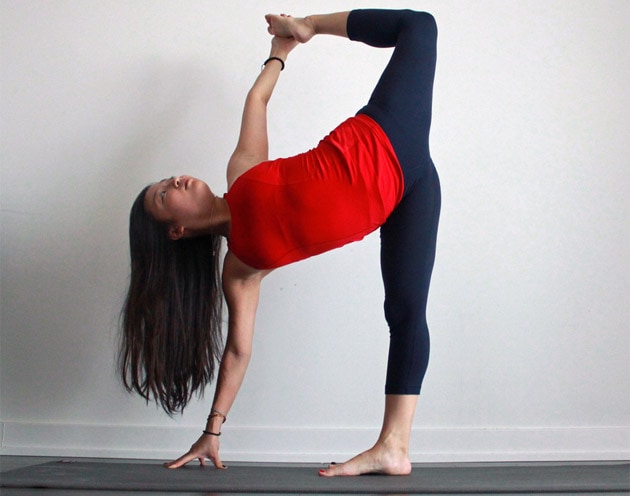True to its name, Sugarcane Pose (Ardha Chandra Chapasana) is a variation of Half Moon Pose that is really sweet and bendy.
There is a sense of spaciousness and expansiveness that comes from opening up through the chest and shoulder, a lovely strength and groundedness through the balance of the standing leg, and a boost of radiance and energy that comes from the asymmetrical backbend.
Taking the time to find a strong and stable expression of Half Moon Pose lays the foundation for the beautiful, open-hearted peak of Sugarcane Pose.
Benefits of Sugarcane Pose
Sugarcane Pose strengthens the ankles, calves, and thighs, and stretches the hip flexors, groins, quadriceps, hamstrings, chest, and shoulders. The pose gently invites openness into the ribcage and the abdominal muscles, lengthens the spine, and helps improve focus, balance, and coordination.
Sugarcane Pose Step-By-Step
- Begin in a Standing Forward Fold (Uttanasana), with the feet parallel and hip distance apart.
- Send the gaze forward, and place the fingertips of your right hand about ten to twelve inches in front of your right foot (depending on the length of your torso), stacking your right shoulder directly over your right wrist.
- Take your left hand onto your left hip, and slowly begin to lift your left foot off the ground, sending your left leg straight back behind you. Remain rooted firmly through all four corners of the right foot.
- Open up through the hips, stacking your left hip on top of your right hip so that your pelvis faces to the left.
- Straighten both legs, drawing up energetically from the sole of the right foot to find lightness in the lifted leg, and keep the left leg parallel to the floor. Keep the left foot flexed and active, extending out through the heel and reaching out through the crown of the head.
- Extend your left arm straight up toward the ceiling, and send your gaze up to your left hand. If there is any strain or discomfort in the neck, keep your gaze down on the ground.
- With an exhalation, begin to bend your left knee and draw your left heel toward your buttock. Reach back with your left hand and take a hold of the left foot.
- As you inhale, press your left foot firmly into your left hand, opening up through the shoulder and chest, and find the simultaneous action of pulling your left foot closer toward you as you press into the hand.
- Continue to revolve the chest open toward the ceiling as you firm your shoulderblades onto your back.
- Remain in the pose for up to five full, deep breaths.
- To come out of the pose, send the gaze back down, release the clasp of the foot, begin to level off the hips, then slowly lower your left foot back down onto the mat and return to a Forward Fold. When ready, repeat on the other side.
Tips
- Rushing is one of the main reasons why balance is lost when reaching for the foot in this pose. Take your time with every step, as if you are building a house and laying a stable foundation, and keep the gaze and the breath steady.
- There’s often a tendency to bend the knee of the standing leg in an effort to overcome the shakiness and unsteadiness that arises in this pose. Rather than bending the knee, keep the quadricep strongly engaged and the kneecap lifted (without hyperextending the knee), and ground down through all four corners of the standing foot.
- This pose demands a certain level of openness in the hips and groins in order to find the full expression of the backbend. Good preparatory poses include Warrior II (Virabhadrasana II), Bound Side Angle Pose (Baddha Parsvakonasana), Extended Hand-To-Big-Toe Pose (Utthita Hasta Padangusthasana), and Half Moon Pose (Ardha Chandrasana).


